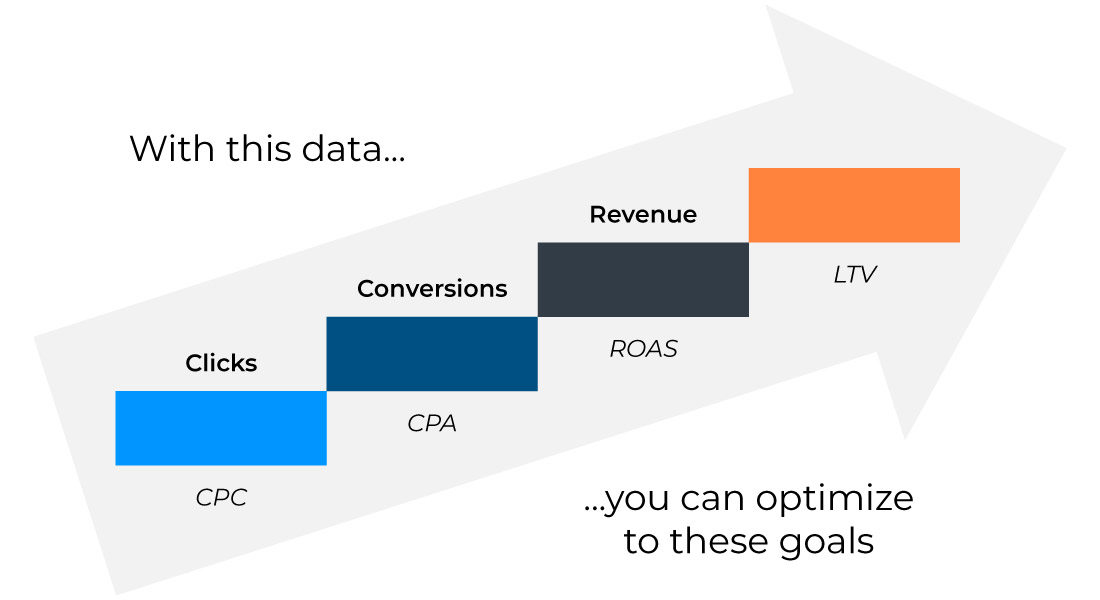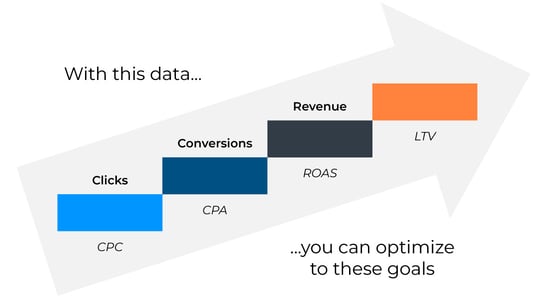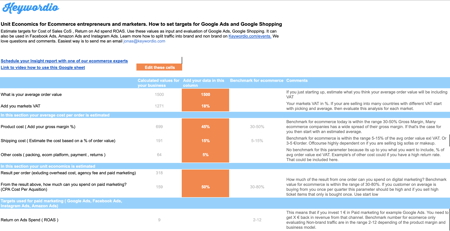

Get monthly notifications
How to calculate ROAS targets in Google Ads with this free tool
How to calculate ROAS targets based my product margins? That is a question many marketers ask themselves. Return On Advertising Spend (ROAS) is a marketing KPI many marketers use to track performance in Google Ads. It’s calculated in Google Ads as ROAS = conversion value / cost. In short, you can evaluate if your investment in online advertising is successful or not. With ROAS Target, you can take it to the next level by automatically adjust your bids depending on product margins if you do it right.
How to calculate ROAS
ROAS is the result you get when dividing revenue earned from advertising with advertising expense. Let’s say you spend €1000 on Google Ads and you earned € 2000 from everyone who clicked on your ads – that means your ROAS is 2000 / 1000 = €2:1. It’s an increase of 200% which means that for every € you spend, you generate 2 € in revenue.
N.B. Make sure you don’t confuse this with calculating ROI. ROAS is the amount of tactical investment - ROI is the amount of strategic investment. Look into our Glossary Cheat Sheet for marketers if you want to know more.

If you want to read more about LTV, check out this post: How to optimize the lifetime value of Google Ads.
What is Target ROAS in Google Ads?
Target ROAS is an automated bid strategy in Google Ads, and it means your bids will automatically adjust depending on the end goal you want to achieve. You set an average conversion value you’d like to get for each dollar you pay on ads. So what is the best possible solution for setting my ROAS Target? Well, that’s depending on your cost structure and what you want to achieve.
Say you want to get eight times the money back from what you spend on an ad – then you set that up and no matter what you spend, that is what you’ll get. And the cool thing is that this usually always works. So here you have a direct promise of ROI which is something you can never be certain of when using other forms of advertising, such as an ad in a newspaper.
You can promote products by pushing them onto customers, the so-called push marketing strategy. On the other hand, you have to pull marketing, where you instead aim to create a loyal customer base and draw interest to your products when people are searching for something. If your company utilize this pulling method, applying ROAS Target to your marketing is a great idea.
Being data-driven is key to acting on fast changes in ROAS. Take our free online course and learn how to set targets for Google Ads and Google Shopping. In this course, you will also get access to two tools that will help you calculate your ROAS targets and track them.
Take the course here: Free Online Course: How eCommerce Should Set Google Ads Targets
Applying ROAS Target to your business
Setting up your ROAS target should be something individually customized for each company. In general, people are just guessing when setting up their targets. At Keywordio we have developed an advanced way of setting targets. We use an algorithm that calculates the ROAS based on what your margins are. Every company needs its own strategy, and you need to ask yourself questions like, Where do I want to end up? Do I need to make a profit from every click? In addition, all costs should be taken into account. Based on all the information you can calculate you need to figure out if you want to go with the conservative approach and save money and don’t take large risks, or if you want to use a more aggressive approach and spend as much as possible to churn out products, move inventory and deliver services.
Three Ways to set your ROAS Targets in Google Ads
Assume you track conversion value including 25% VAT in Google Ads. If you sell a product for €100 after someone clicked on your Google shopping ad, €100 is tracked as the conversion value in Google Ads. Your revenue, excluding VAT, will be €80. Let's look at three scenarios and what your result would be in each one of them.
Simplified based on product margins
Start with understanding your cost structure and expected margin.
| Product margins, the typical gross margin | 50 % |
| Logistic | 10 % |
| Other | 15 % |
| Conversion Value in Google Ads | €100 |
| Excluding VAT | €80 |
| Cost product | -€40 |
| Cost logistic | -€8 |
| Other costs | -€12 |
| Results from Google Ads | €20 |
Based on this let's say you can spend 50% of the result from Google Ads on marketing. 50% of €20 is €10. This gives you your ROAS target of 10. (Spending €10 with a required minimum of €100 in conversion value tracked in Google Ads, ROAS Target = conversion value over cost = 100/10 = 10).
The neglected cost in this simplified analysis is an overhead cost, agency cost warehouse or lost sales.
Calculate ROAS based on the cost of sales targets
Many eCommerce companies work with a cost of sales targets. They are typically defined for each channel or as a guideline. The cost of sales is the inverse of ROAS, meaning that the 10% cost of sales target is 1/10% = 10 ROAS.
This is a detailed analysis based on product margins.
Here is a template in Google Sheets where you can calculate your ROAS target based on your product margins.

| Product margins, typical gross margin | 50 % |
| Logistic | 10 % |
| Overhead cost | 10 % |
| Agency cost | 10 % |
| Warehouse | 5 % |
| Lost sales | 5% (orders that won't be fulfilled for example because of out of stock or returns) |
| Conversion Value in Google Ads | €100 |
| Excluding VAT | €80 |
| Cost product | -€40 |
| Cost logistic | -€8 |
| Agency cost | -€8 |
| Warehouse | -€4 |
| Lost sales | -€4 |
| Results from Google Ads | €16 |
Based on this let's say you can spend 50% of the result from Google Ads on marketing. 50% of €16 € is €8. This gives you your ROAS target of 12.5. (Spending €8 with a required minimum of €100 in conversion value tracked in Google Ads, ROAS Target = conversion value over cost = 100/8 = 12.5).
All your keywords and products will have different ROAS when you track that KPI in Google Ads. With different margins, you can also allow different spend. Keywordio runs millions of this analysis for our customers, making sure you spend your marketing budget optimally based on your strategy.
Schedule a call with one of our senior eCommerce experts and learn how to accelerate your growth.
Featured Articles
The Full Funnel Approach and Pinterest
Today, we're going to delve into the significance of working with a full-funnel strategy and understanding why a comprehensive media mix is crucial. We'll also explore an example of how this approach and including Pinterest in the media mix led to a significant decrease in the cost of sales for Houdini.
Master Text Overlays: Boost Ad Engagement
In recent years, capturing the attention of your target audience has become more challenging than ever. Businesses and marketers are constantly on the lookout for innovative ways to stand out in the crowded advertising landscape.
One effective technique to draw attention to your ad's message is through the use of text overlays on image and video ads. In this blog, we will explore the best practices for incorporating text overlays, ensuring your message is impactful without compromising the visual appeal of your ads.
Similar Articles
Protect Your Facebook Business Account from Phishing: Expert Tips by Keywordio
Hello everyone, Johan here from Keywordio. Today, I want to share crucial insights into phishing—what it is and how you can safeguard your Facebook business account from this prevalent threat.
Exploring the Future of TikTok: Insights from the 2024 Trend Report
Introduction
I'm excited to delve into TikTok's comprehensive "What's Next 2024 Trend Report." This report is a treasure trove for anyone in digital marketing, offering deep insights into the future of content, storytelling, and consumer engagement on TikTok.
E-Commerce Excellence: Meta's Advantage+ Shopping Campaigns Redefined
Welcome to the dynamic world of e-commerce, where Meta's Advantage+ shopping is reshaping how businesses connect with customers. In this blog post, we'll explore the key features of this innovative tool.
Introducing TikTok Shop
Today, I bring to your attention a revolutionary update from TikTok, a platform where over 150 million Americans seek daily doses of inspiration and entertainment. With a plethora of trends, fashion hacks, beauty nuggets, and a smattering of recipes, TikTok has emerged as a modern-day oracle for curious minds. The excitement in the air thickens as we unveil TikTok Shop to the US, an avant-garde conduit for folks to spot and snag their adored items seamlessly.
The Full Funnel Approach and Pinterest
Today, we're going to delve into the significance of working with a full-funnel strategy and understanding why a comprehensive media mix is crucial. We'll also explore an example of how this approach and including Pinterest in the media mix led to a significant decrease in the cost of sales for Houdini.
Master Text Overlays: Boost Ad Engagement
In recent years, capturing the attention of your target audience has become more challenging than ever. Businesses and marketers are constantly on the lookout for innovative ways to stand out in the crowded advertising landscape.
One effective technique to draw attention to your ad's message is through the use of text overlays on image and video ads. In this blog, we will explore the best practices for incorporating text overlays, ensuring your message is impactful without compromising the visual appeal of your ads.
The Next Big Thing: 5 Digital Marketing Trends to Watch for in 2023
Digital marketing is a constantly evolving field, shaped by emerging technologies, changing consumer behaviors, and the dynamic nature of the online landscape. Staying on top of the latest trends is crucial for businesses and marketers to effectively engage with their target audience and drive growth. In this introduction, we will explore some of the key digital marketing trends that have emerged in recent times.
The Power of Branding on Meta
Are you ready to unlock unparalleled opportunities and take your online business to new heights? In a rapidly evolving digital landscape, Meta continues to revolutionize the way marketers and entrepreneurs create an impact on buyers.
Today, we will talk about the immense potential of branding on Meta's platforms, Facebook and Instagram based on our Meta Branding (Online Course). Brace yourself for insights that will empower you to establish a strong brand identity, harness consumer trends, and optimize your advertising strategies like never before! Ready to spearhead your business to success? by understanding the potential of branding on Meta and how you can tap into it. Excited? So are we - let's get into it!
A Sneak Peek into Pinterest's 2023 Product Updates!
Pinterest is improving its Ads Manager to provide a seamless experience for advertisers. New features will be released throughout 2023 to optimize advertising strategies. Pinterest aims to offer powerful tools and insights for better campaign results. Get a sneak peek into the exciting updates coming to Ads Manager this year.